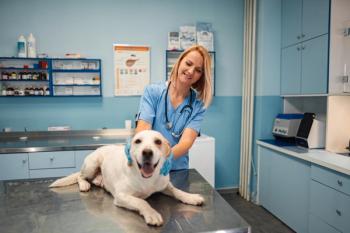
The technician exam: how to increase your self esteem and your value to your practice (Proceedings)
Few management experts would argue that one of the key aspects of a successful practice is effective delegation.
Few management experts would argue that one of the key aspects of a successful practice is effective delegation. This is something as equally important to the small one or two doctor practice as it is to a 15-20 multi-doctor one. Most successful veterinarians understand this concept and therefore delegate much responsibility to their paraprofessional staff, most notably their technicians.
Unfortunately for many of you there exists quite a large number of veterinarians who haven't yet developed this skill and still think they need to do everything themselves in order for it to be done right. By doing so, these veterinarians are underutilizing one of their most valuable assets, YOU!
We need to change these archaic practices, or more accurately, you do. Today we are going to cover the various ways I utilize my technicians and hopefully you will then take these tips with you when you get back to work. You are too valuable and important to your employers to not be performing to your full potentials. You need to show your bosses that by actually doing the work you were trained to do you will increase their efficiency and by doing so increase their gross revenues and profits.
Well let's get started. The first place to "strut your stuff" is in the examination room, by performing what I call the "tech exam." This is a simple eight part exam that you do before the doctor even steps one foot into the examination room. It gives you the opportunity to take a patient history, perform your tech exam, and educate your clients about your hospital's products and services. The first thing you want to do is greet your client and patient. In some practices this may be done in the reception area and the responsibility of escorting a client into an exam room is the technician's, while in others the client and pet(s) may already be waiting in the exam room. Introduce yourself if the client is one you don't yet know, and make sure to acknowledge and warm up to the pet!
Now you want to take a brief history. Find out why the pet is being brought in and jot down the key problems. Ask how long the problems have been going on and if the client might be aware of anything which may have contributed to them. If the pet is coming in for a routine check-up and vaccinations, get all the vaccines ready for the doctor. If the problem is, for example, an ear infection, get a slide and swab ready, and even a culture swab if the ear looks very inflamed and is oozing. The basic idea is you want to do whatever is necessary to prepare for the doctor's own exam. If you note that vaccinations are due, but the client didn't want to have them done, take this opportunity to educate and inform your client about the diseases you vaccinate for and how important these vaccines are for the continued health of their pet. Saving the doctor some valuable time should always be one of your priorities.
Now you can start your examination. To keep it simple, I recommend you start at the head end and work back. As you examine the pet, you want to check for any obvious abnormalities, note them, then talk to your client about them. If you know your doctors well and you are very familiar with their style and approach, you can even mention to the client how the doctor may want to proceed. The important thing to remember is to write everything down, including your comments, so you don't make a fool out of your boss.
1.Weight: This is often done out in the reception area, but if not, now is a good time to do it.
2. Temperature: You can either do this now before you begin your exam, or later on when you check the hind end.
3. Eyes: Note any discharge, haziness, redness, inflammation, or any other abnormality. If you suspect a corneal problem, get everything ready for a stain.
4. Ears: Are they smelly? Inflamed? Is there any discharge? If so, what does it look like? Ask if the pet has been scratching his/her ears. Prepare necessary swabs and smears, then if the doctor allows go ahead and clean them.
5. Nose: Look for a discharge and any crusts or scabs.
6. Mouth: Check out the teeth and gums looking for plaque build up, and gum inflammation. Here's your big chance to educate and sell! Talk about the various products you offer to help keep their pet's mouth healthy, and discuss exactly what is done during the prophy and polish procedure and why it is so important.
7. Skin and Coat: Check for external parasites like fleas and ticks and look for problems like hair loss, scabs, sores, irritation, etc. Ask the owner if the pet has been scratching a lot. It's very important here that you note your findings and even discuss them with the client, but don't make any diagnoses. If you know your boss well and you think he or she may want to do a skin scraping, get everything ready! If you notice a flea problem, here's your opportunity to talk about flea control and the products you have which can help. Finally, check under the tail looking for tapeworms or any irritation. If you haven't already done so earlier, now is a good time to take the pet's temperature.
8. Feet and Nails: Here's your last stop! Note any redness or moisture, the pads themselves, and the areas in between the digits. If the nails need trimming, ask the owner if he or she would like it done.
Now that was easy! After doing a few of these and getting good at them your boss is going to love the fact that you've just made his or her job a little bit easier, and that you've saved him or her quite a bit of valuable time. Very possibly, you might catch something that your boss may overlook. "Two heads are better than one!" When I walk into an examination room I always look over my tech's findings before I begin my own examination as this helps point out any areas which may need a little extra attention. Sometimes the doctor may want you to stick around during his/her exam, especially if the animal is tough to handle. After all, it's okay for you to get bitten, but it's never okay for an owner to get bitten.
Once the doctor has completed his or her examination, you can get started admitting the patient if it is going to stay, preparing medications if needed, or initiating diagnostic tests if indicated.
I hope it is now obvious to you that you should never feel useless or underutilized. Technicians should be, and are, an integral "link" in the practice "chain" without which the practice is really incomplete. You can, and should, add to your practice's productivity, gross revenue, and public image. If you are currently contributing the way you should, well that's terrific, and if not, it's never too late to start. If any of you have employers who still won't let you perform and contribute the way you've been trained to, have them talk to some practice managers who I'm sure, if given the chance, can set them straight. Good luck!
Newsletter
From exam room tips to practice management insights, get trusted veterinary news delivered straight to your inbox—subscribe to dvm360.






